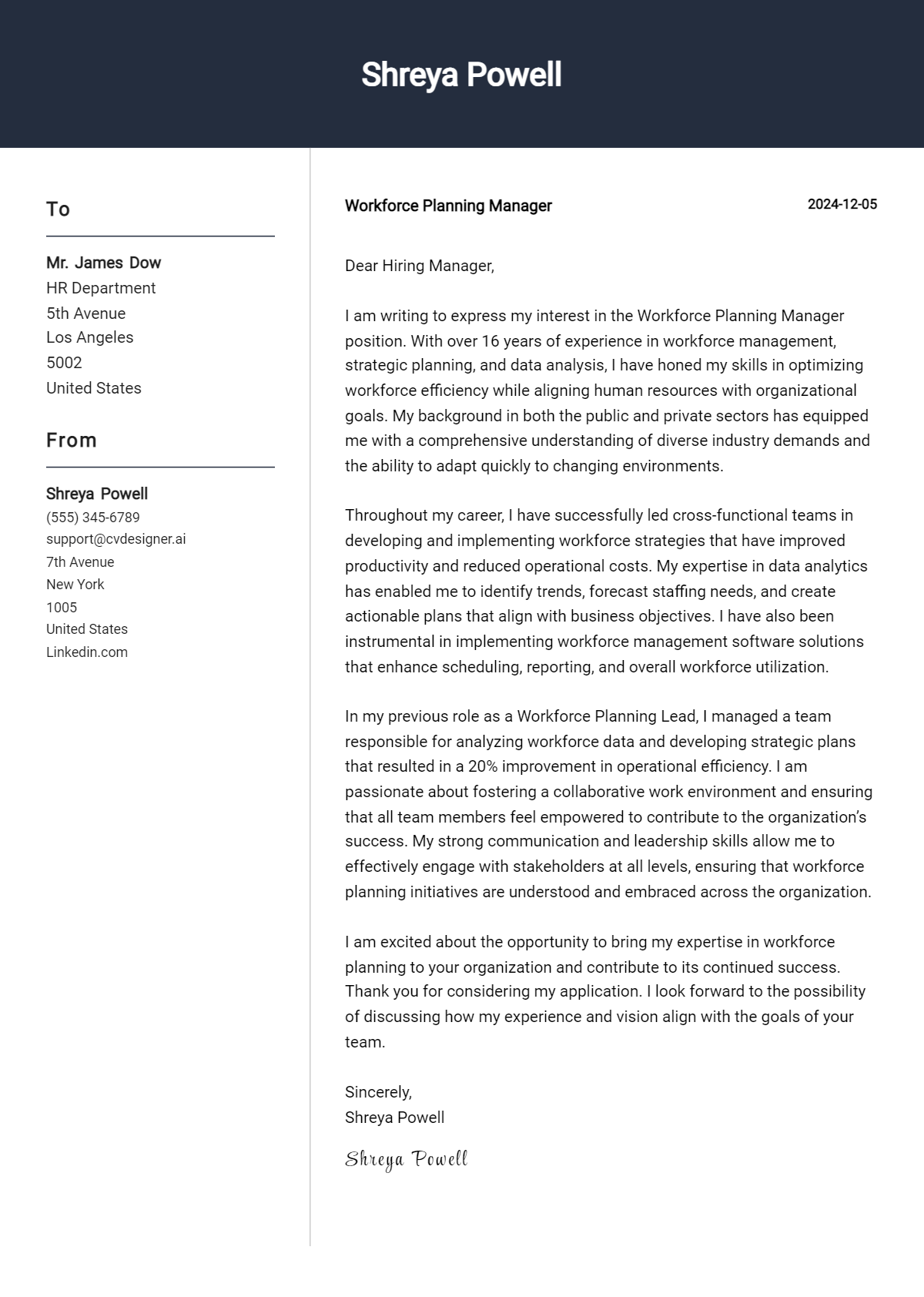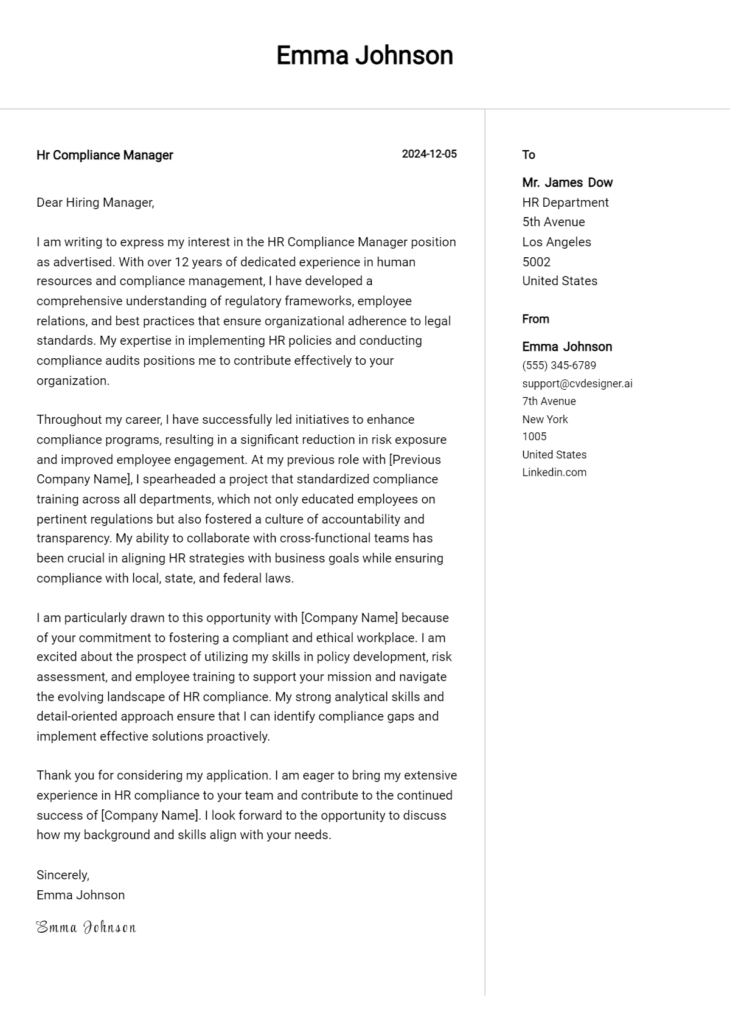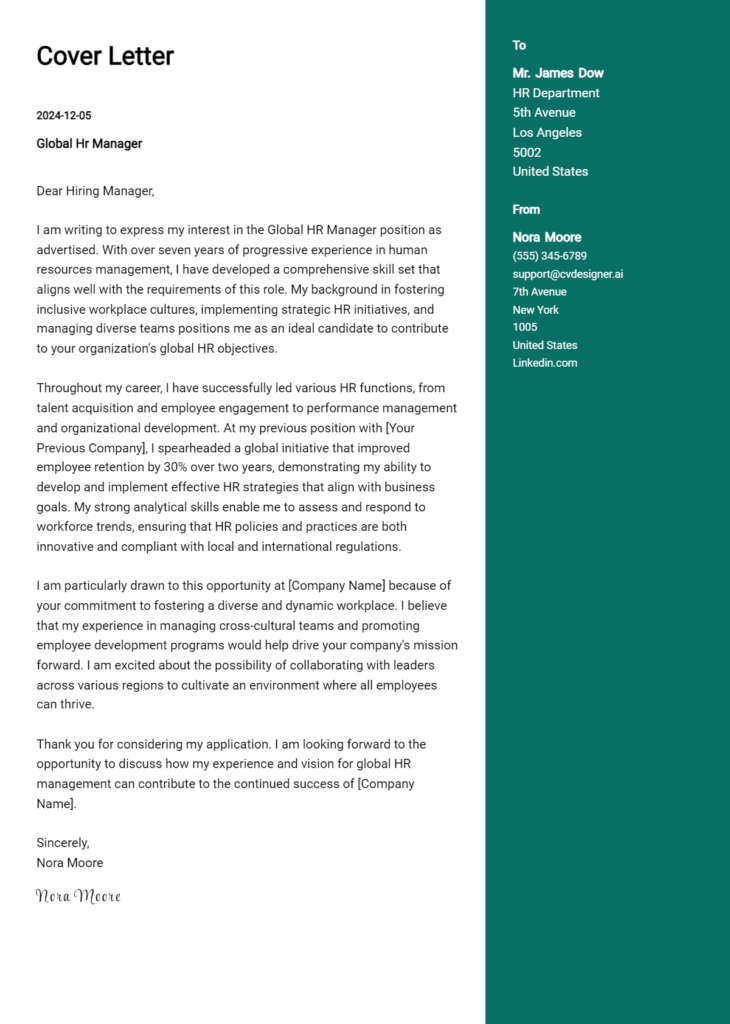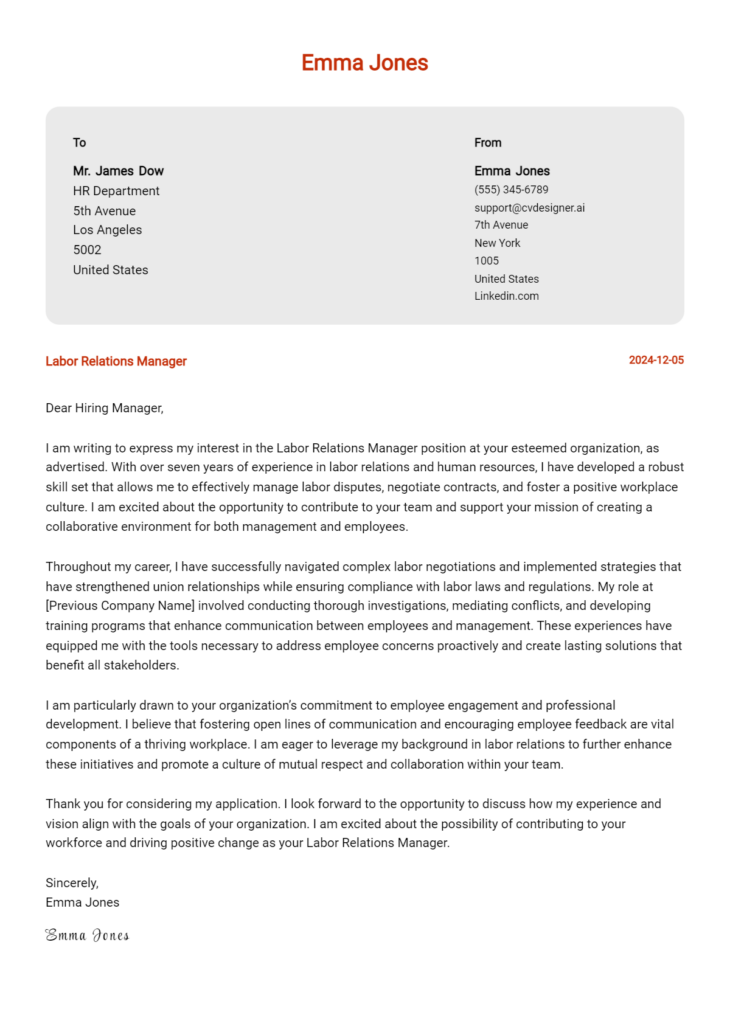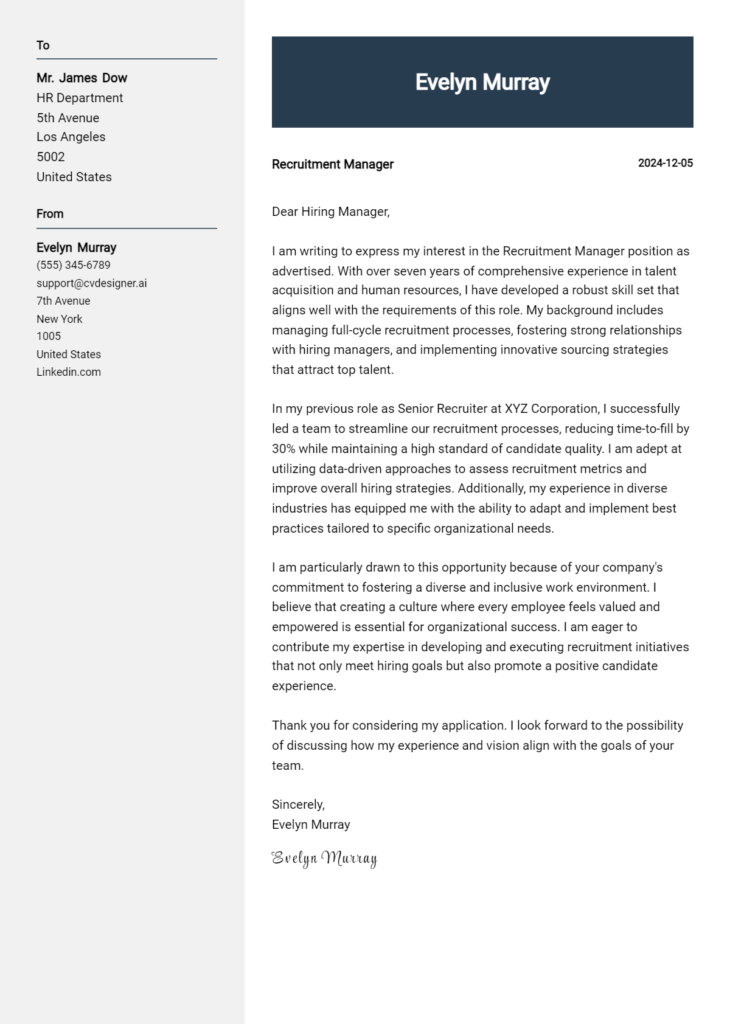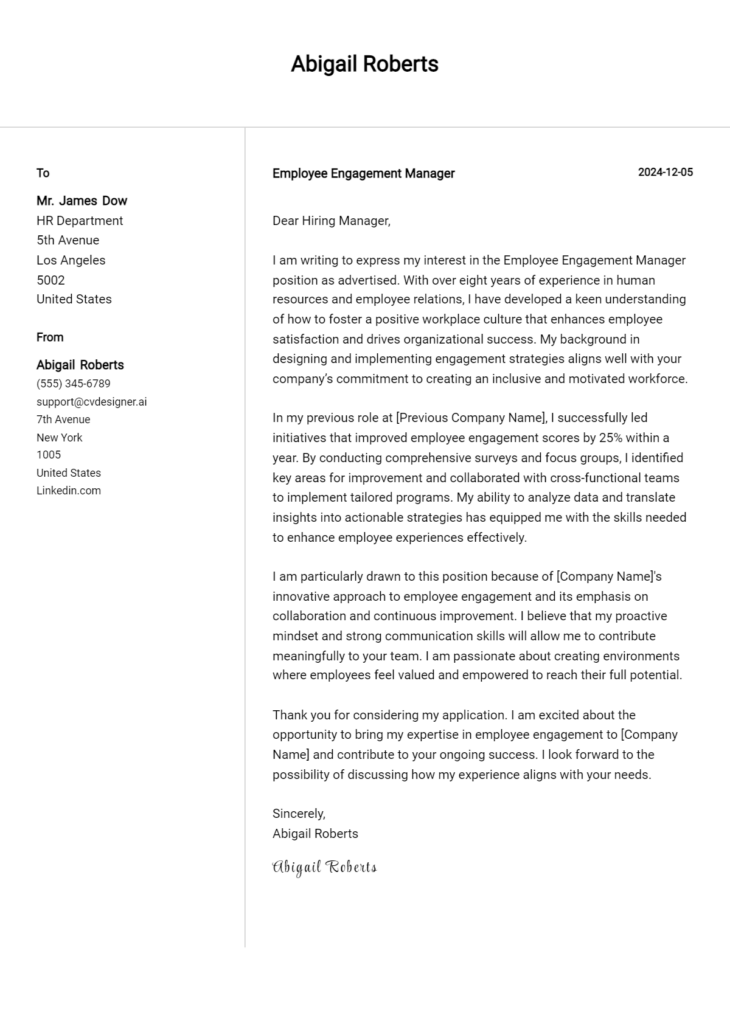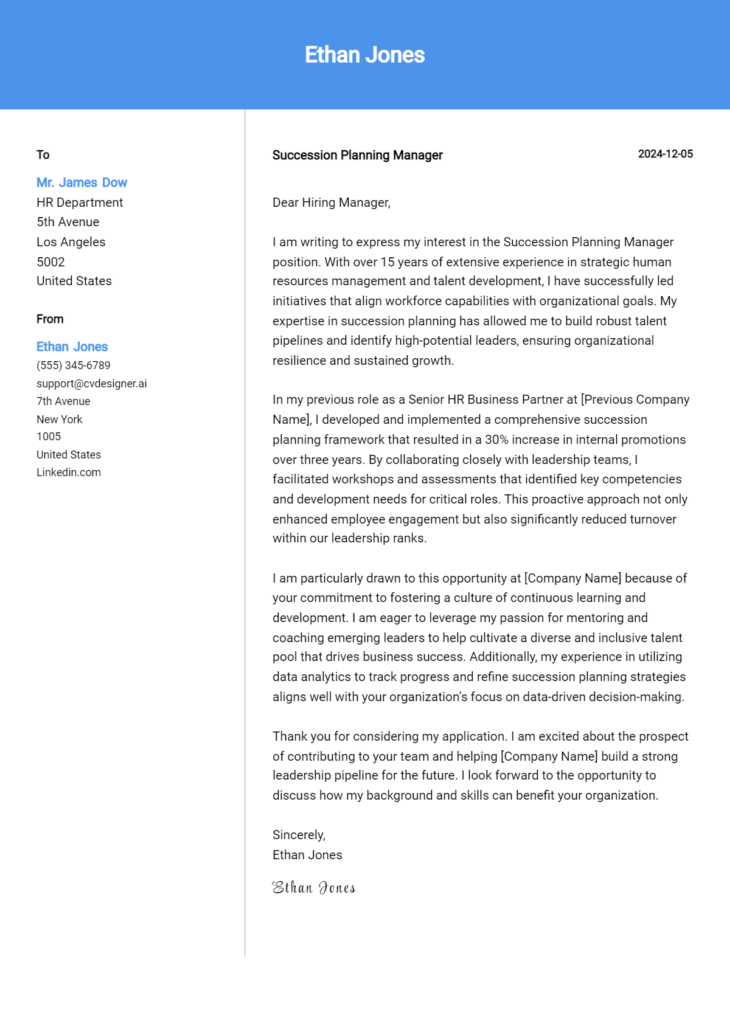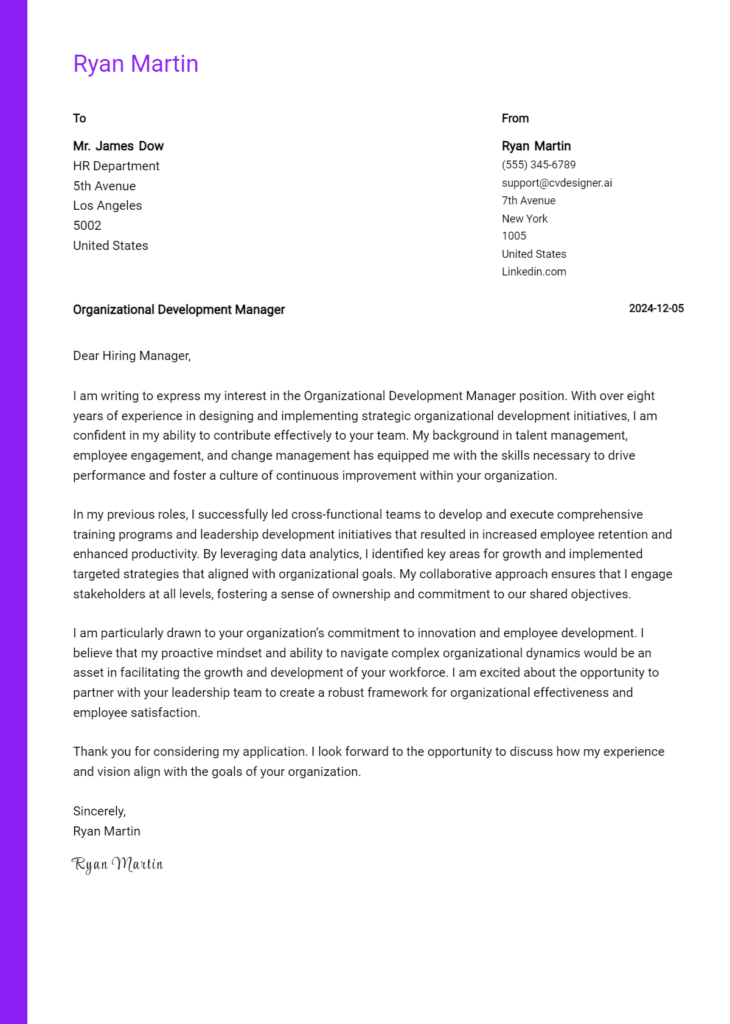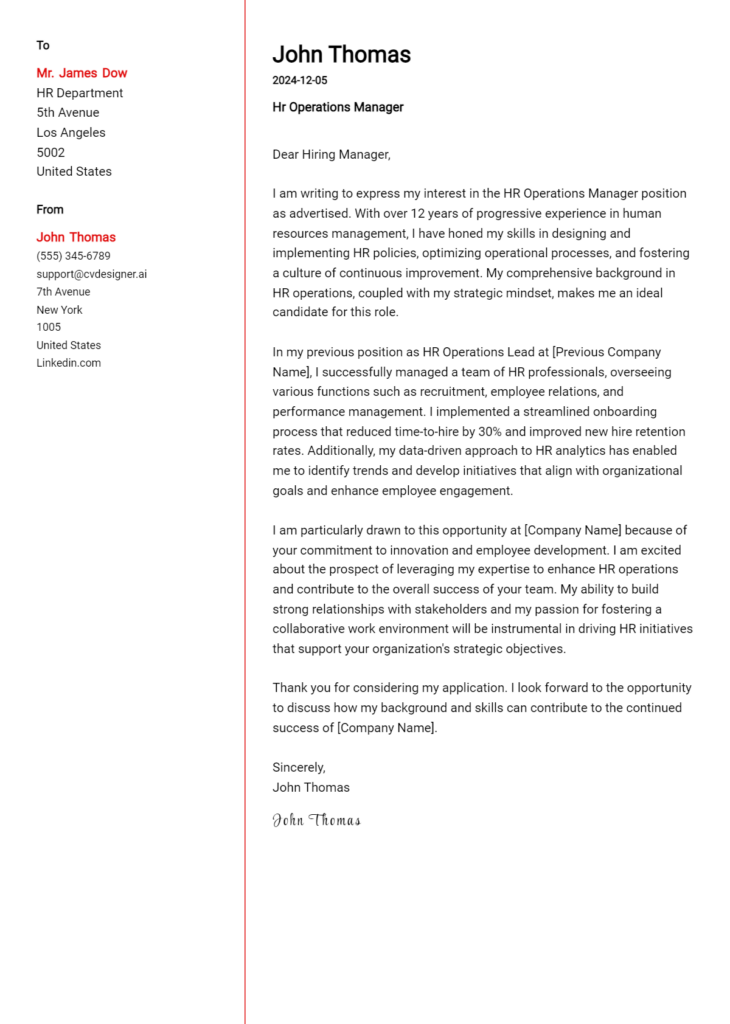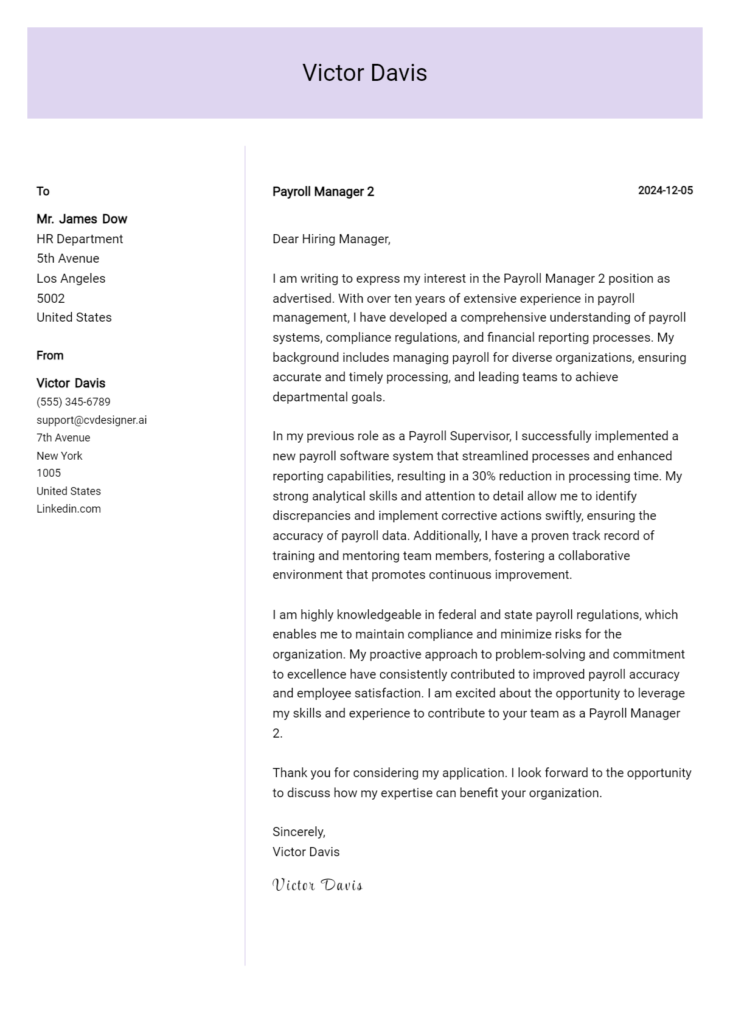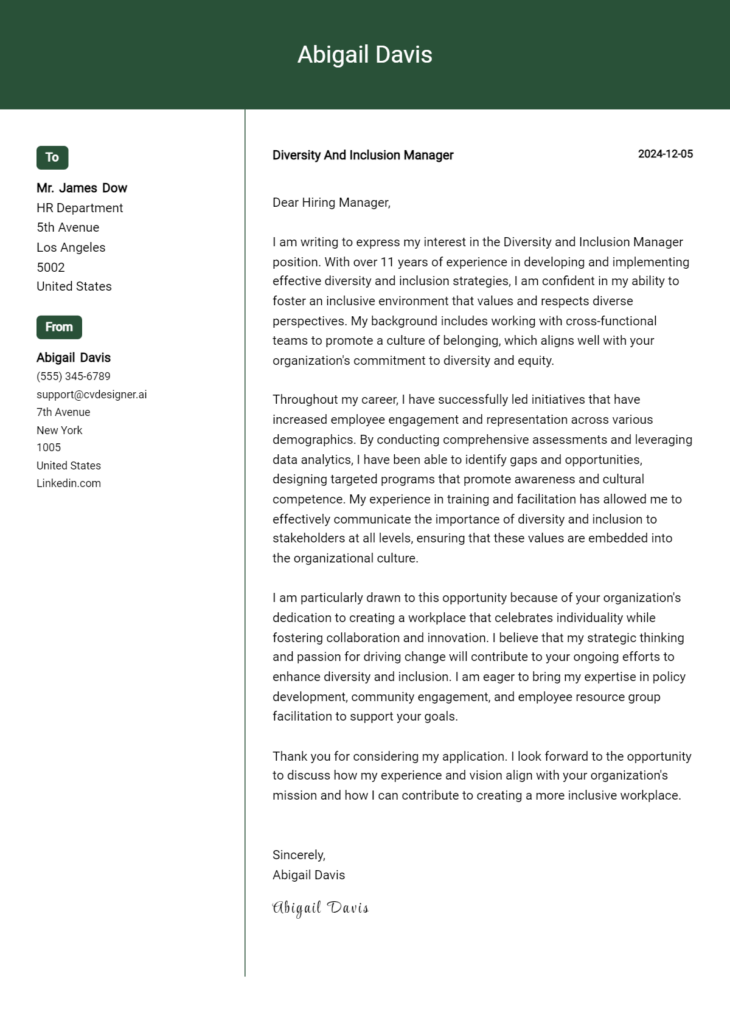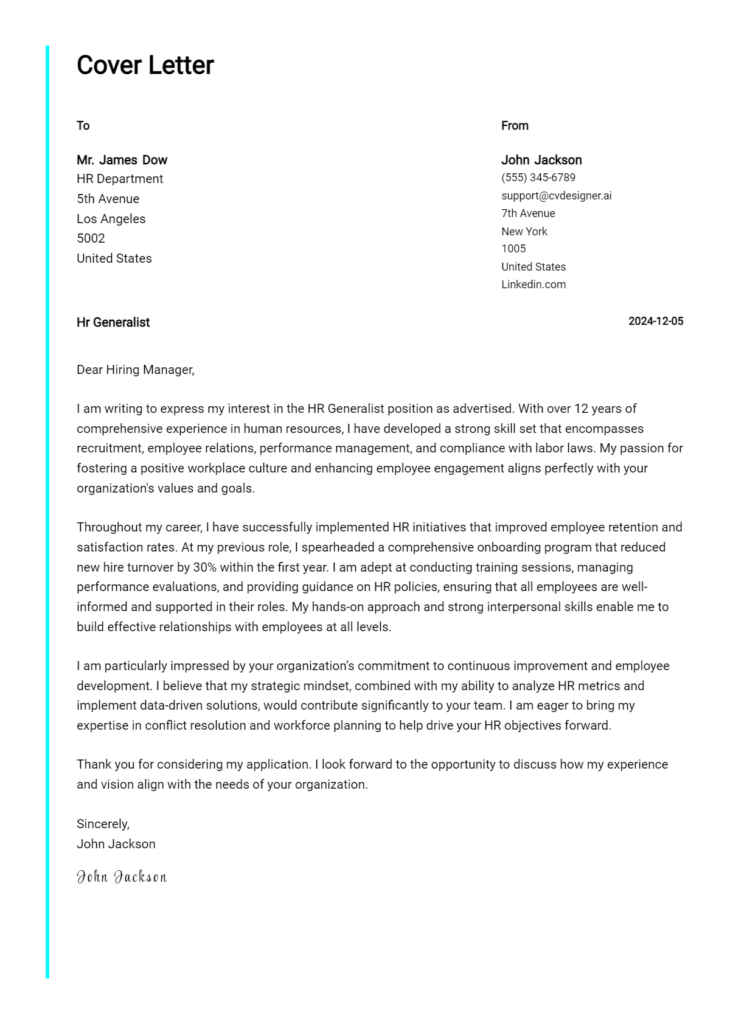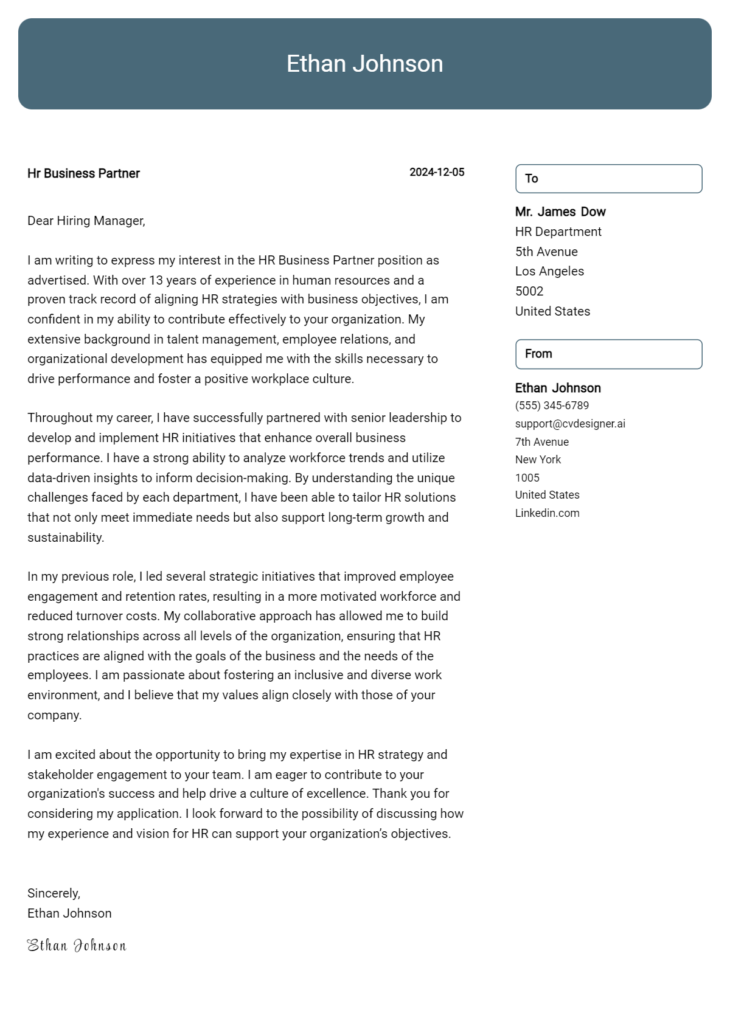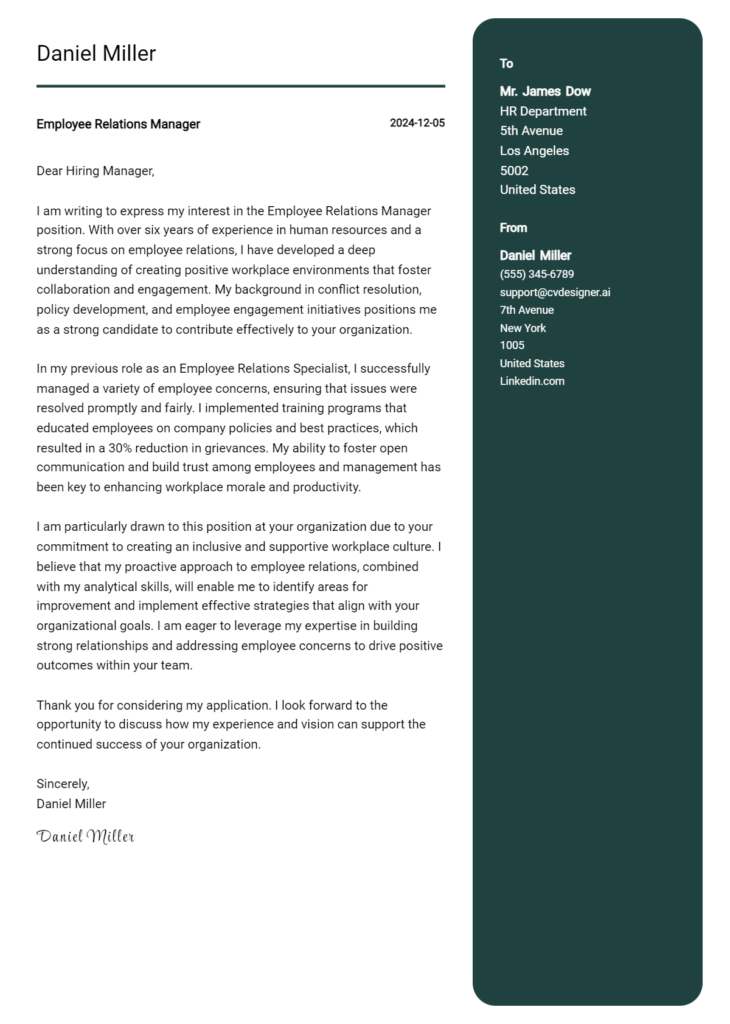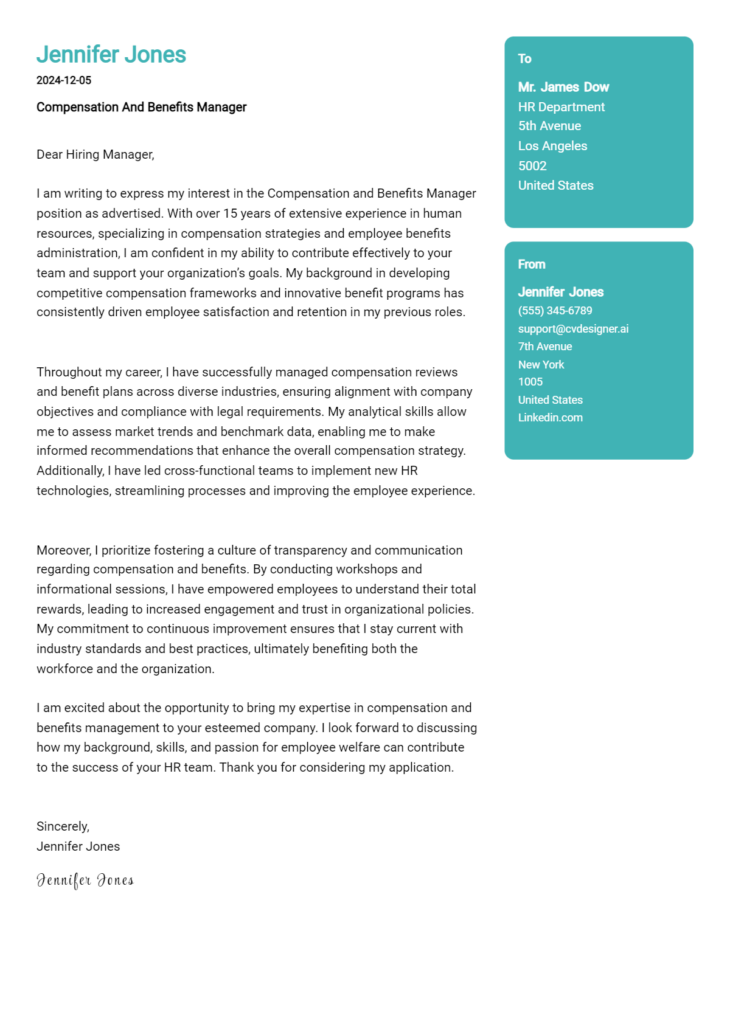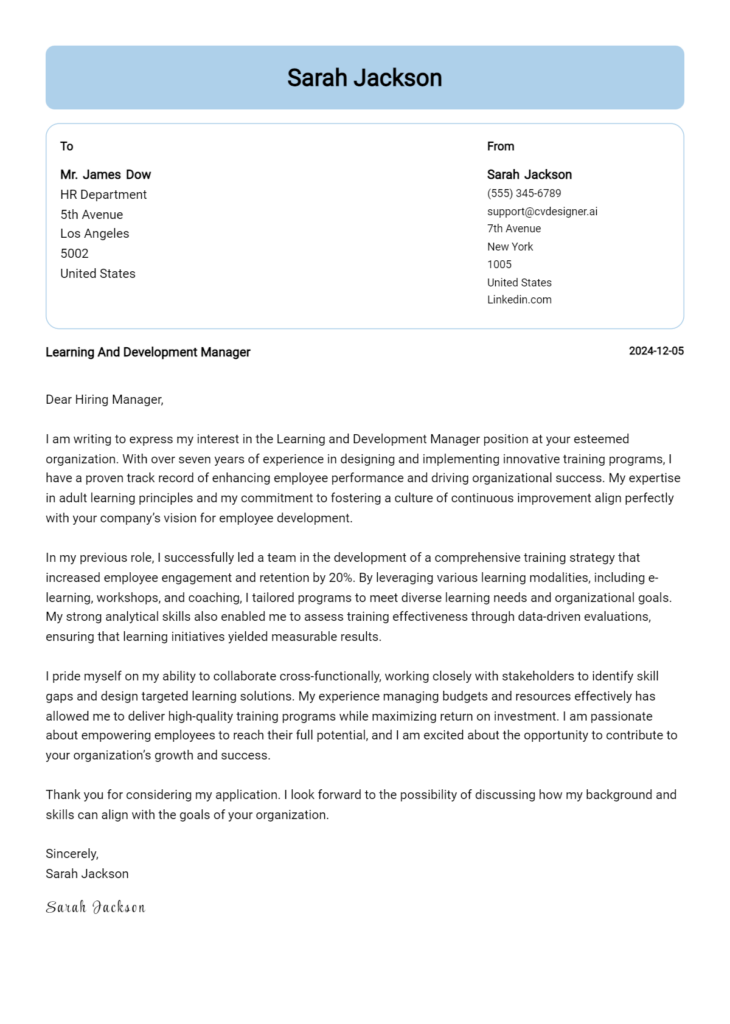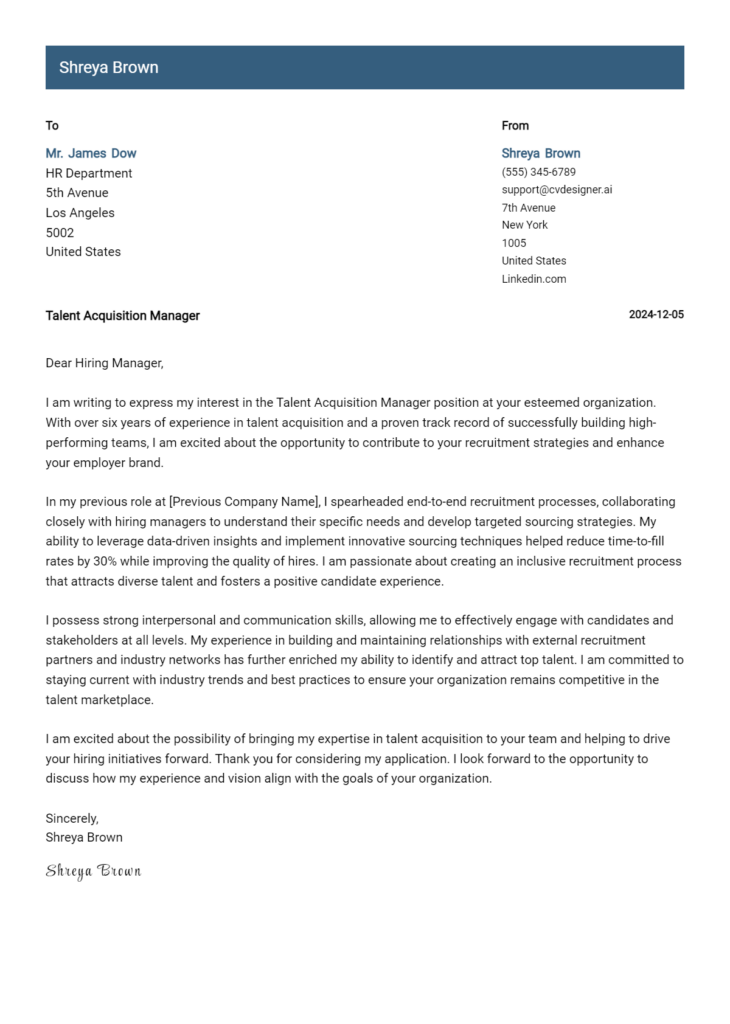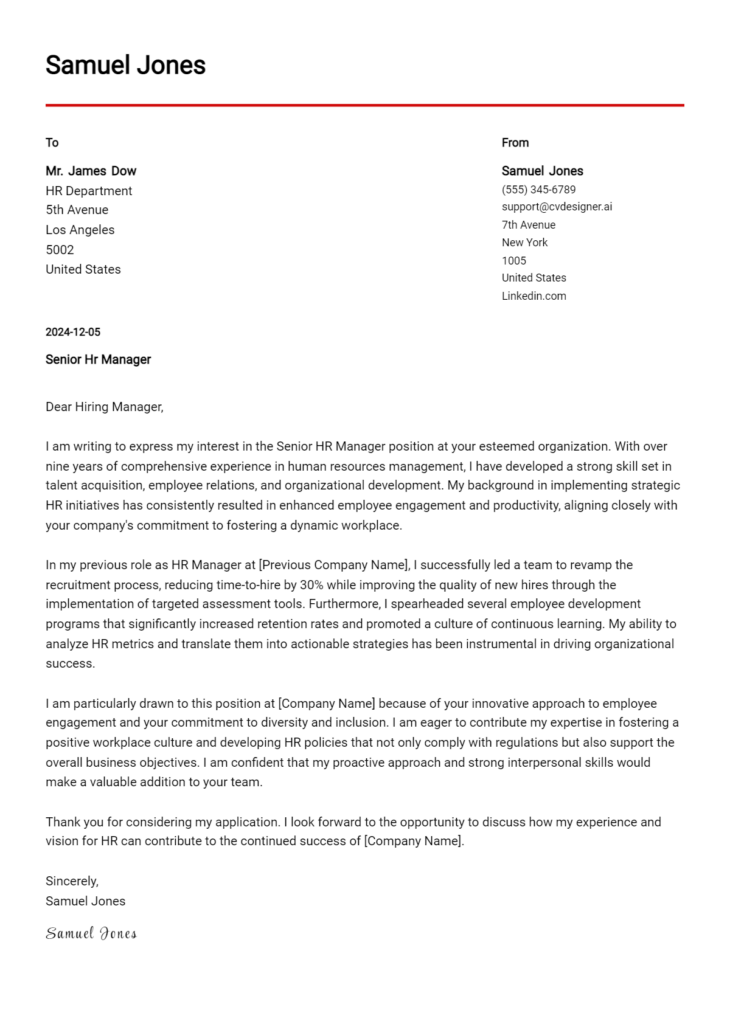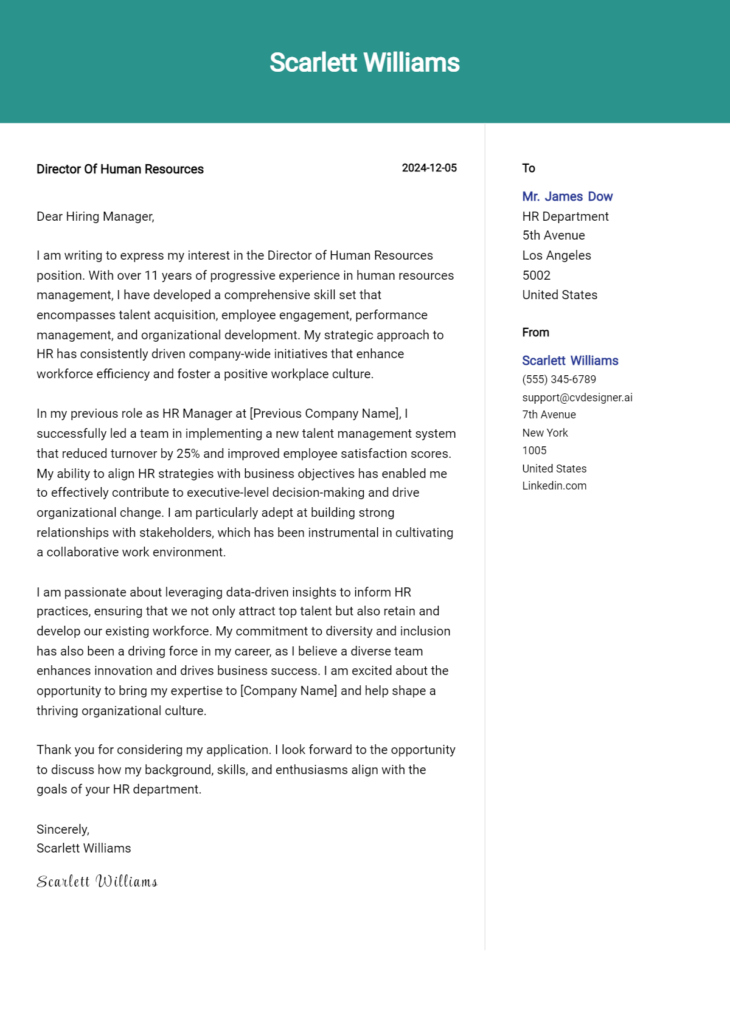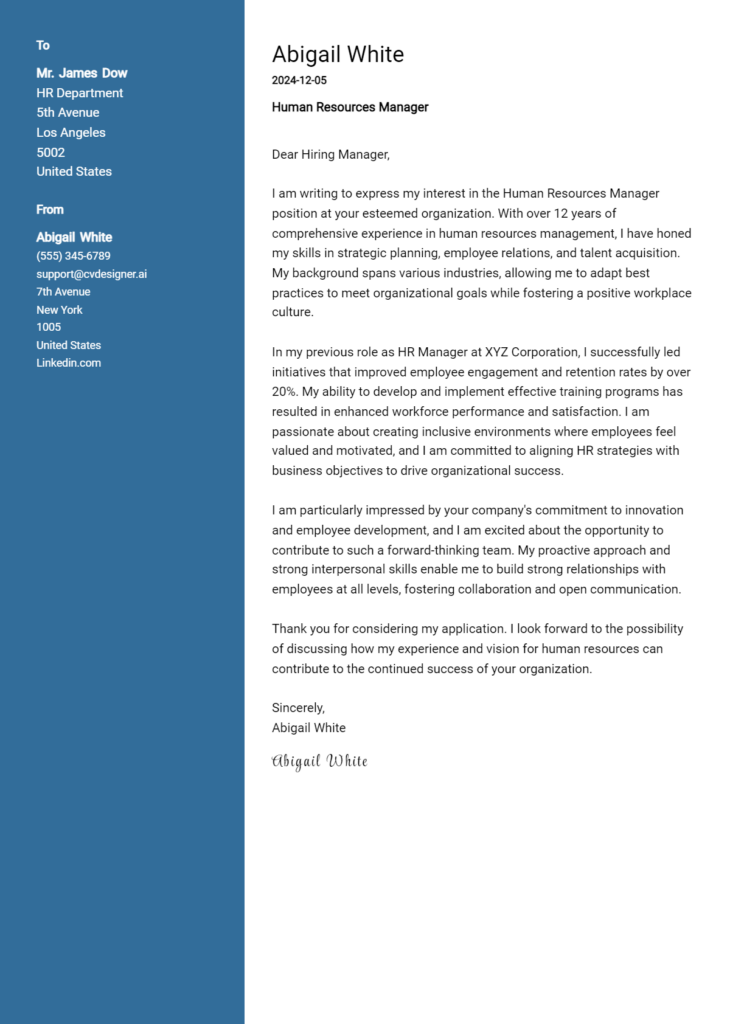Workforce Planning Manager Cover Letter Examples
Explore additional Workforce Planning Manager cover letter samples and guides and see what works for your level of experience or role.
How to Format a Workforce Planning Manager Cover Letter?
Crafting a compelling cover letter for a Workforce Planning Manager position is essential in showcasing your strategic thinking and organizational skills. The way you format your cover letter not only conveys your professionalism but also reflects your ability to analyze workforce dynamics and develop effective plans. A well-structured cover letter serves as a powerful tool to grab the hiring manager's attention and demonstrate your expertise in workforce analysis, forecasting, and resource allocation—key competencies for a successful Workforce Planning Manager.
In this guide, we will explore how to structure your cover letter, providing insights and examples specific to the workforce planning field to help you create a persuasive document.
We'll focus on the essential components of a professional cover letter, including:
- Cover Letter Header
- Cover Letter Greeting
- Cover Letter Introduction
- Cover Letter Body
- Cover Letter Closing
Each section is crucial for highlighting your qualifications and showcasing your professionalism. Let’s delve into each part and discover how to make your Workforce Planning Manager cover letter stand out.
Importance of the Cover Letter Header for a Workforce Planning Manager
The cover letter header is a crucial component of your application as a Workforce Planning Manager, as it sets the tone for your communication and establishes professionalism. A well-structured header provides essential information that allows the recipient to identify you and your qualifications quickly. It should include your contact information, the date, and the recipient's details. Clarity and professionalism in this section not only help in making a strong first impression but also ensure that your application is easily navigable for the hiring manager.
A strong header conveys confidence and attention to detail, while a weak header may create confusion or convey a lack of seriousness. Below are examples of both a strong and a weak cover letter header for a Workforce Planning Manager.
Strong Example
John Doe 123 Workforce Lane Cityville, ST 12345 (123) 456-7890 johndoe@email.com [Date] Hiring Manager Company Name 456 Business St. Cityville, ST 12345
Weak Example
JD 12345 (123) 456-7890 [Date] To Whom It May Concern Company Name
The Importance of a Strong Cover Letter Greeting
The greeting of a cover letter serves as the initial handshake between you and the hiring manager, setting the tone for the rest of your application. A well-crafted greeting demonstrates professionalism and shows that you have taken the time to personalize your communication. By addressing the hiring manager directly, you create an immediate connection and convey your genuine interest in the position. To avoid generic greetings that can come off as impersonal, it's essential to research the recipient's name whenever possible. This small effort can make a significant difference in how your cover letter is perceived.
Here are some tips for crafting an effective greeting:
- Use a specific name: Whenever possible, find out the name of the hiring manager or recruiter.
- Avoid generic phrases: Steer clear of greetings like "To Whom It May Concern," as they can suggest a lack of effort.
- Be respectful: Use appropriate titles (Mr., Ms., Dr.) if you know the person's name.
Strong Greeting Example:
Dear Ms. Johnson,
Weak Greeting Example:
To Whom It May Concern,
By applying these principles to your cover letter greeting, you can make a strong first impression that resonates throughout your application.
Importance of a Well-Crafted Cover Letter Introduction for a Workforce Planning Manager
A well-crafted cover letter introduction is crucial for a Workforce Planning Manager as it serves as the first impression for the hiring manager. This introductory paragraph should not only capture attention but also convey the candidate's enthusiasm for the role while succinctly highlighting relevant skills or achievements. A strong introduction can set the tone for the rest of the cover letter, showcasing the candidate's suitability for the position and increasing the likelihood of securing an interview. Below are examples of both strong and weak introductions to illustrate the difference.
Strong Example
Dear [Hiring Manager's Name], I am excited to apply for the Workforce Planning Manager position at [Company Name], as advertised on [where you found the job posting]. With over eight years of experience in strategic workforce planning and a proven track record of optimizing talent acquisition processes, I am eager to bring my expertise in data-driven decision-making and cross-functional collaboration to your dynamic team. My ability to align workforce strategies with business goals has consistently resulted in improved operational efficiency and employee satisfaction, and I am motivated to contribute to [Company Name]'s continued success.
Weak Example
To Whom It May Concern, I am writing to express my interest in the Workforce Planning Manager role at [Company Name]. I have worked in human resources for a few years and think this job looks okay. I believe I can help the company, and I’m hoping to get a chance to discuss this opportunity further.
Purpose of the Cover Letter Body for a Workforce Planning Manager
The cover letter body for a Workforce Planning Manager serves as a critical platform to articulate the candidate's unique qualifications, relevant experiences, and the value they can bring to the organization. This section should effectively highlight specific projects or accomplishments that demonstrate the candidate's ability to optimize workforce efficiency, manage staffing needs, and contribute to strategic planning. By detailing their expertise in data analysis, resource allocation, and forecasting, candidates can clearly illustrate how their background aligns with the company's goals and challenges.
Strong Example
In my previous role as a Workforce Planning Analyst at XYZ Corporation, I led a project that successfully reduced overtime costs by 20% through the implementation of a predictive analytics model. By analyzing workforce trends and collaborating with department heads, I was able to forecast staffing needs accurately, ensuring we had the right number of employees at peak times. This not only improved operational efficiency but also enhanced employee satisfaction, as workloads were balanced more effectively. My experience in leveraging data-driven insights equips me to make informed decisions that align with your strategic goals.
Weak Example
I have experience in workforce planning and I think I could be a good fit for your company. I have worked in similar roles before and I am familiar with some of the tasks that a Workforce Planning Manager does. I believe that I can help your team, but I haven't done any specific projects that I can mention. I am looking forward to the opportunity to work with you.
Importance of the Cover Letter Closing for a Workforce Planning Manager
The closing of a cover letter is crucial for a Workforce Planning Manager as it is the final opportunity to leave a strong impression on the hiring manager. It should effectively summarize qualifications, reiterate enthusiasm for the role, and encourage the next steps, such as reviewing the resume or scheduling an interview. A well-crafted closing can reinforce your suitability for the position and demonstrate your proactive approach, while a weak closing can diminish the impact of an otherwise strong application.
Strong Example
Thank you for considering my application for the Workforce Planning Manager position. With over eight years of experience in strategic workforce planning and a proven track record of optimizing talent resources, I am excited about the opportunity to contribute to your team. I look forward to discussing how my skills align with your organization's goals and would appreciate the chance to speak further about this role. Please feel free to review my resume for additional details, and I hope to schedule an interview soon.
Weak Example
Thanks for looking at my cover letter. I think I might be a good fit for the Workforce Planning Manager job, but I’m not really sure. I guess you can check my resume if you want to. Let me know if you want to meet, I guess.
When applying for a Workforce Planning Manager position, crafting a compelling cover letter is essential to stand out among candidates. This document should effectively highlight your technical skills, problem-solving abilities, knowledge of the Software Development Life Cycle (SDLC), teamwork experience, and a commitment to continuous learning. Below are some tips to help you create an impactful cover letter that showcases your qualifications and enthusiasm for the role.
Cover Letter Writing Tips for Workforce Planning Manager
Highlight Technical Skills
Make sure to showcase your technical proficiencies relevant to workforce planning. Mention specific tools, software, or methodologies you have experience with, such as data analysis tools, workforce management systems, or forecasting models. Relating these skills to the requirements mentioned in the job description can demonstrate your preparedness for the role.Emphasize Problem-Solving Abilities
Include examples that illustrate your problem-solving capabilities. Describe a challenging situation you faced in a previous role and explain how you developed a solution that positively impacted workforce efficiency or project outcomes. Use metrics to quantify your success when possible, as this adds credibility to your claims.Demonstrate Knowledge of SDLC
If relevant to the position, discuss your familiarity with the Software Development Life Cycle. Explain how your understanding of SDLC processes enhances your ability to plan workforce needs effectively. This can indicate that you are well-versed in aligning workforce strategies with project timelines and deliverables.Showcase Teamwork Experience
Workforce Planning Managers often work with cross-functional teams. Highlight your collaborative experiences, detailing how you have successfully worked alongside various departments to achieve common goals. Discuss any leadership roles you’ve taken on and how you facilitated teamwork in past projects.Express Passion for Continuous Learning
Employers appreciate candidates who are committed to professional development. Share your dedication to continuous learning by mentioning relevant certifications, courses, or workshops you have completed. This can demonstrate your proactive approach to staying updated with industry trends and best practices, making you a valuable asset to the organization.
By utilizing these tips, you can create a strong cover letter that not only highlights your qualifications but also reflects your enthusiasm for the Workforce Planning Manager role. For additional resources, consider exploring cover letter templates or using a cover letter builder to streamline the process.
Common Mistakes to Avoid in a Workforce Planning Manager Cover Letter
Crafting a compelling cover letter is essential for standing out in the competitive job market, especially for a strategic role like Workforce Planning Manager. Avoiding common mistakes can significantly enhance your chances of making a positive impression. Here are some prevalent pitfalls to watch out for:
Generic Content: Tailoring your cover letter to the specific role and company is crucial. Avoid using a one-size-fits-all approach. Research the organization to incorporate relevant details that show your genuine interest.
Neglecting Format: Using an incorrect or unprofessional format can detract from your message. Adhere to a clear and professional cover letter format that enhances readability.
Lack of Specificity: Failing to provide concrete examples of your accomplishments can weaken your narrative. Instead, include specific metrics or outcomes from your past experiences in workforce planning.
Overly Complex Language: While professionalism is key, using convoluted language can obscure your message. Aim for clarity and conciseness, making your points easy to understand.
Ignoring Keywords: Many employers use applicant tracking systems (ATS) to filter applications. Ensure that your cover letter includes relevant keywords from the job description to increase your chances of getting noticed.
Forgetting a Call to Action: Not concluding your letter with a strong call to action can leave it feeling incomplete. Consider inviting the hiring manager to discuss your application further.
Proofreading Errors: Spelling and grammatical mistakes can undermine your professionalism. Always proofread your cover letter or have someone else review it before submission.
For inspiration, explore various cover letter examples to see effective ways to present your qualifications and avoid these common mistakes.
Cover Letter FAQs for Workforce Planning Manager
What should I include in my cover letter for a Workforce Planning Manager position?
In your cover letter, you should highlight your relevant experience in workforce planning, data analysis, and strategic resource allocation. Discuss specific projects where you successfully optimized staffing levels or improved operational efficiency. Mention your proficiency with workforce management software and data analytics tools, as these are crucial for the role. Additionally, emphasize your ability to collaborate with cross-functional teams, as effective communication is vital. Tailor your letter to the job description, incorporating keywords and phrases to demonstrate your fit for the company’s needs.
How can I demonstrate my leadership skills in my cover letter?
To showcase your leadership skills, provide examples of times you led a team or project that had a significant impact on workforce planning. Describe your approach to mentoring team members and how you fostered a collaborative environment. Highlight any initiatives you spearheaded that resulted in improved processes or employee engagement. Use metrics to quantify your success, such as reductions in turnover rates or increases in productivity. By illustrating your leadership style and achievements, you can effectively convey your capability as a Workforce Planning Manager.
How can I tailor my cover letter to a specific company?
Research the company's culture, values, and mission to tailor your cover letter effectively. Start by addressing the letter to a specific hiring manager if possible, as this personal touch shows genuine interest. Incorporate specific details about the company’s workforce challenges or initiatives mentioned in the job posting. Align your skills and experiences with their needs, demonstrating how your background can help them achieve their workforce goals. Finally, express enthusiasm for their projects or values, showing that you are not just looking for any job, but are genuinely interested in contributing to their success.
Should I include salary expectations in my cover letter?
Typically, it is not advisable to include salary expectations in your cover letter unless the job posting specifically requests it. The cover letter should focus on your qualifications, experiences, and enthusiasm for the role. Introducing salary discussions too early can detract from your main message and potentially limit your negotiating power later. If asked in the interview process, be prepared to discuss your salary expectations based on market research and your experience level. For now, concentrate on making a strong case for why you are the ideal candidate for the Workforce Planning Manager position.
Build your Cover Letter in minutes
Use an AI-powered cover letter builder and have your letter done in 5 minutes. Just select your template and our software will guide you through the process.

